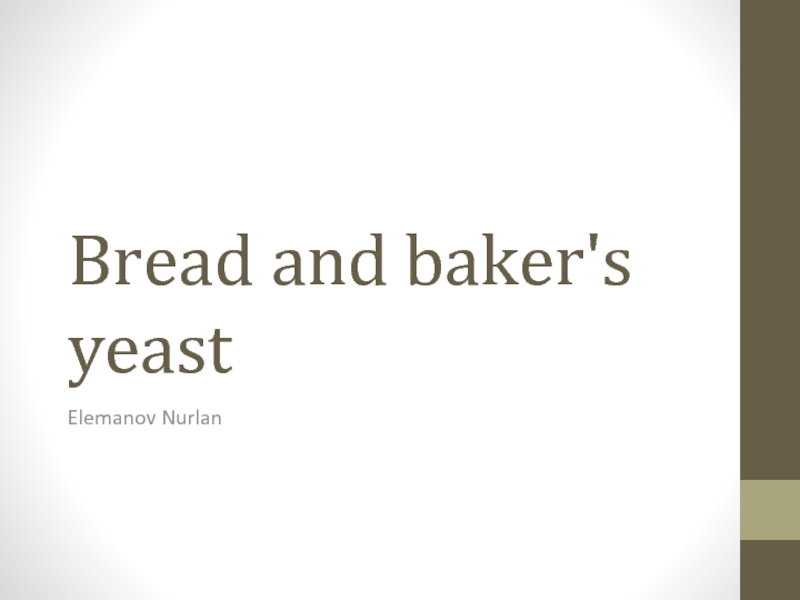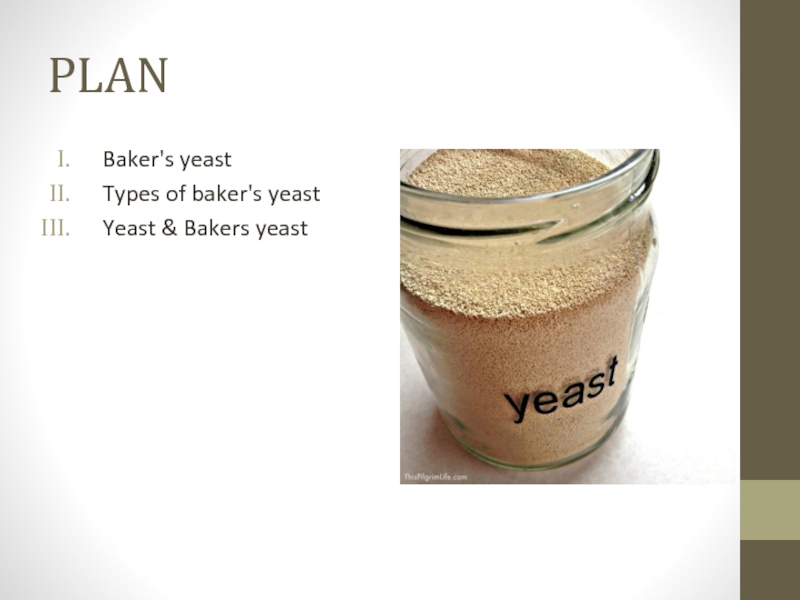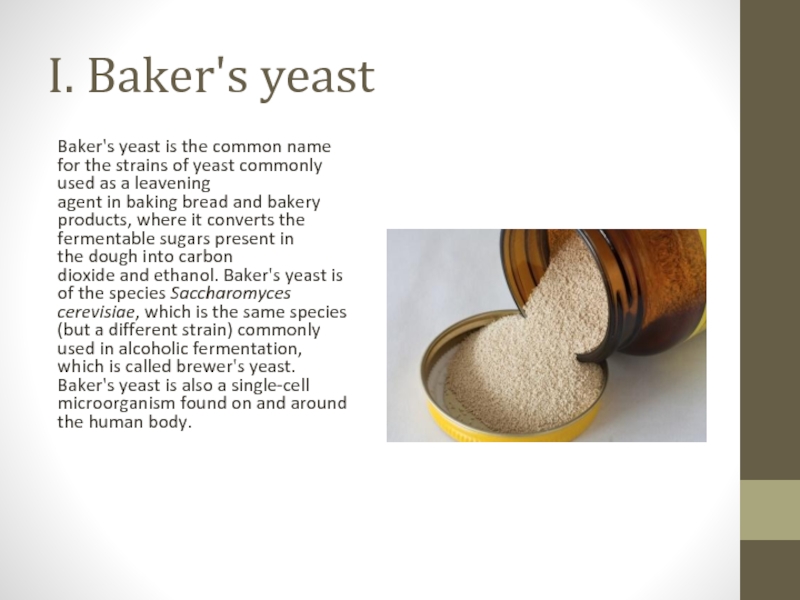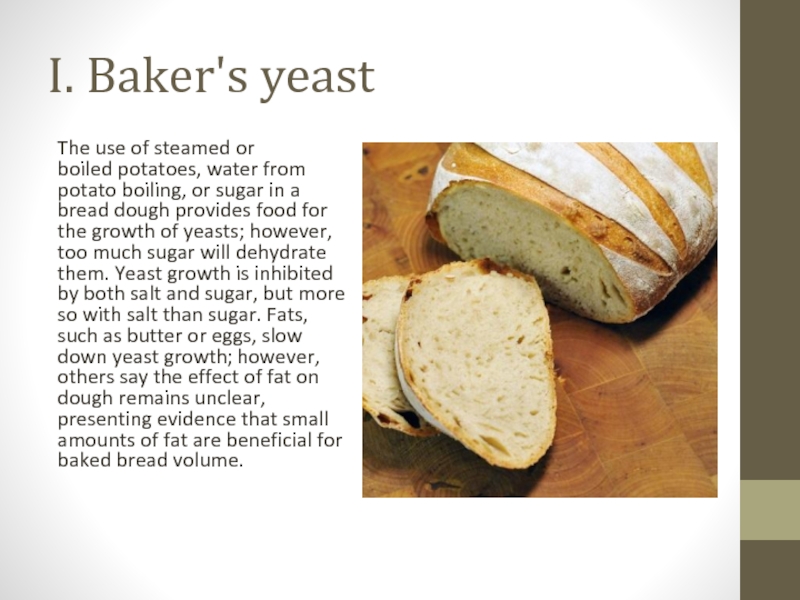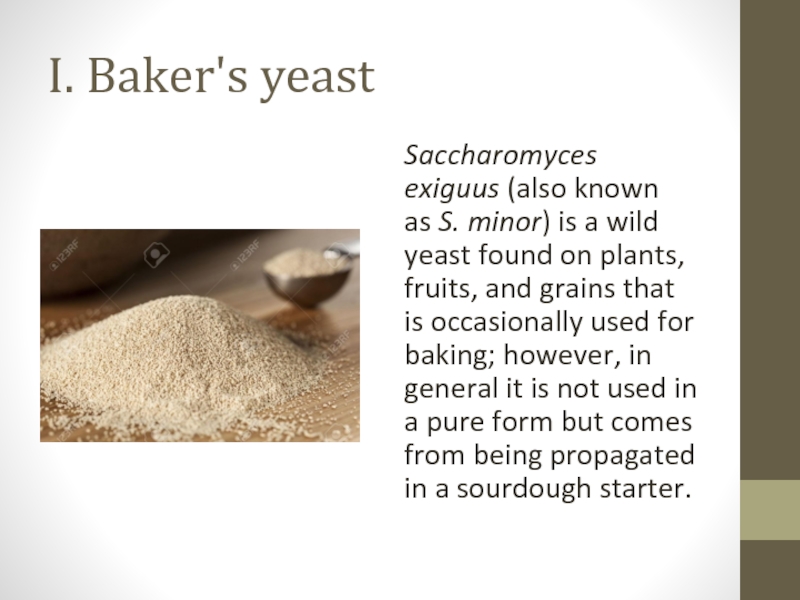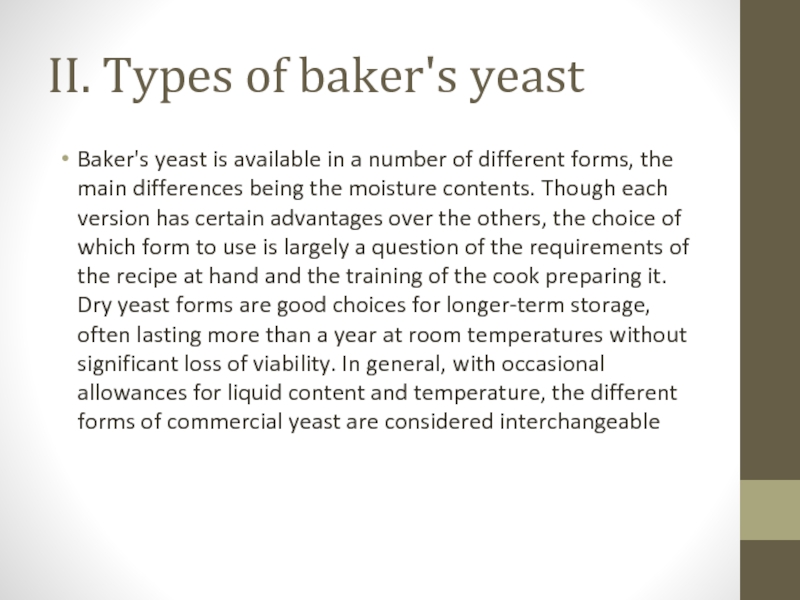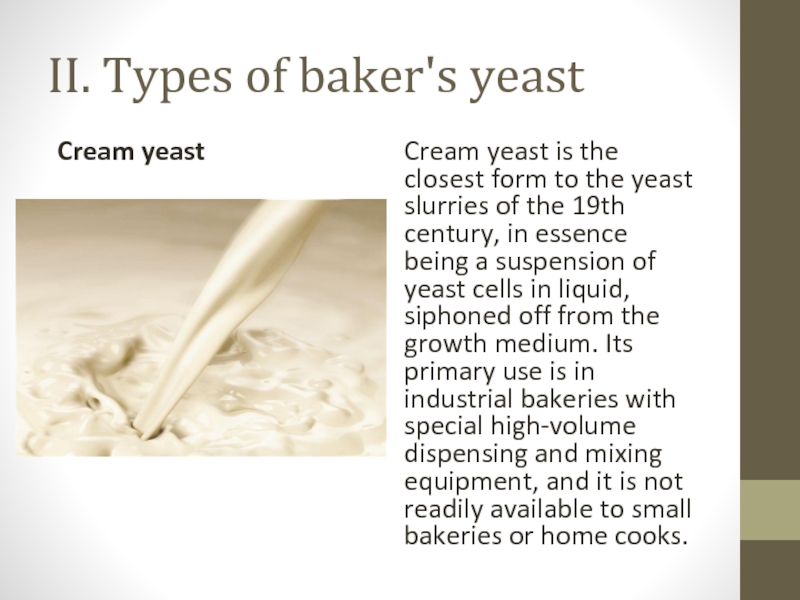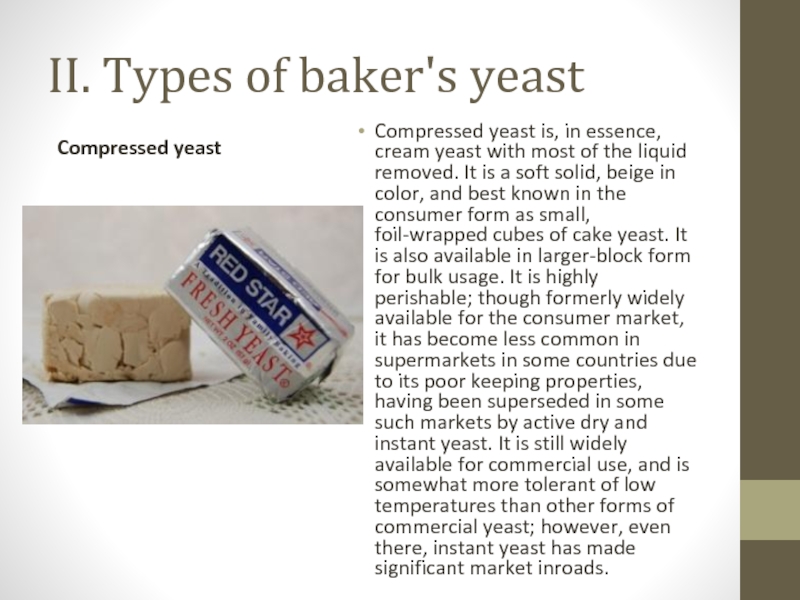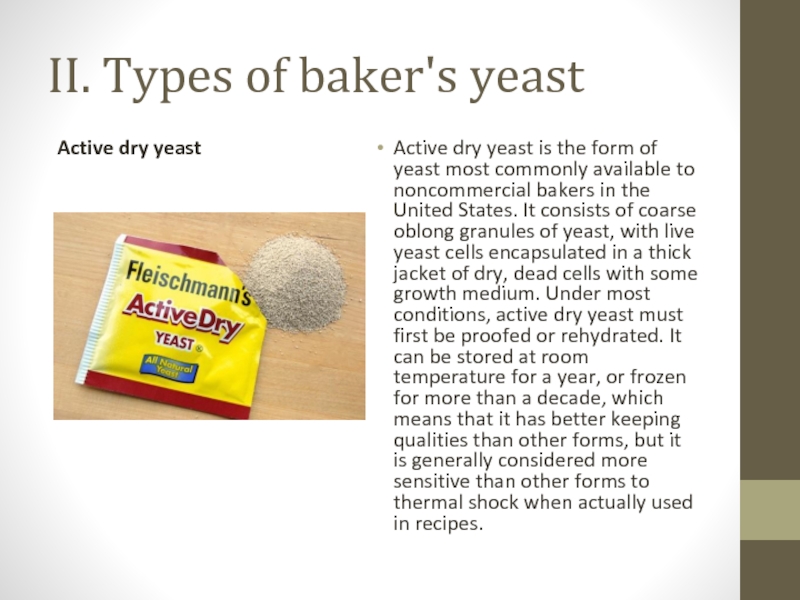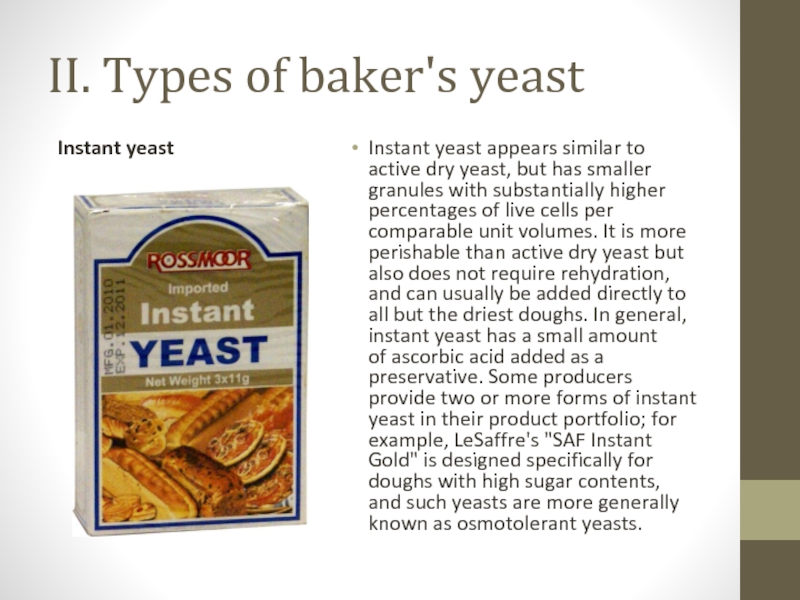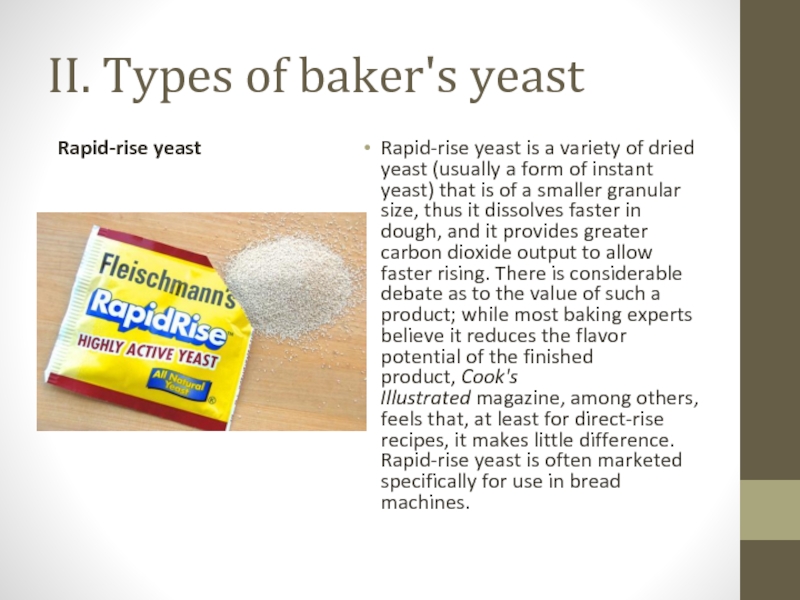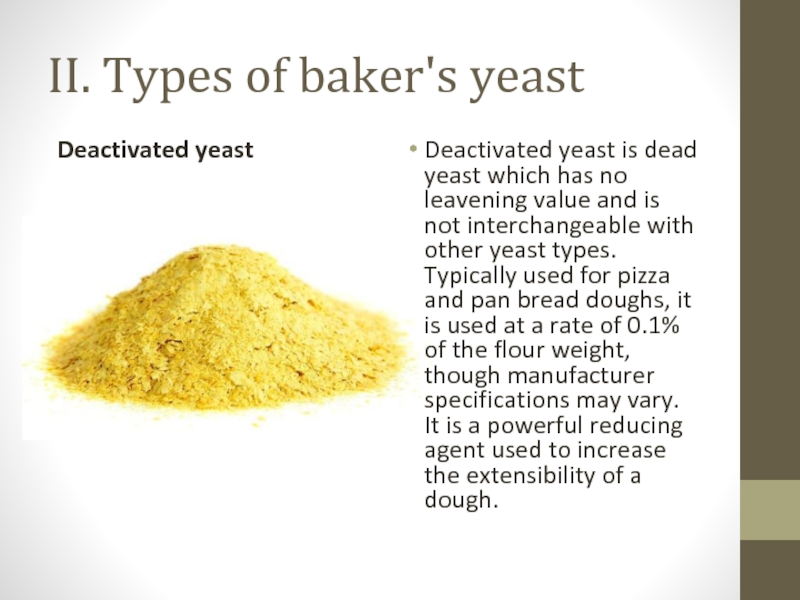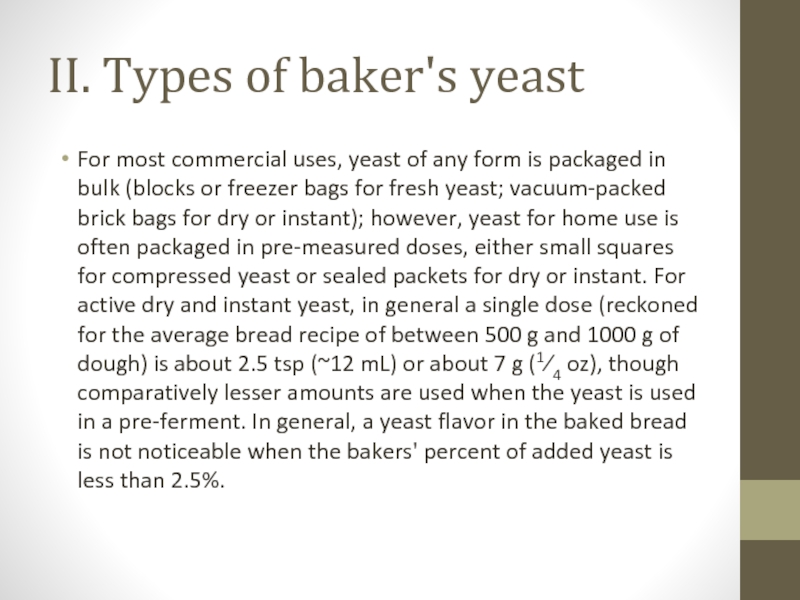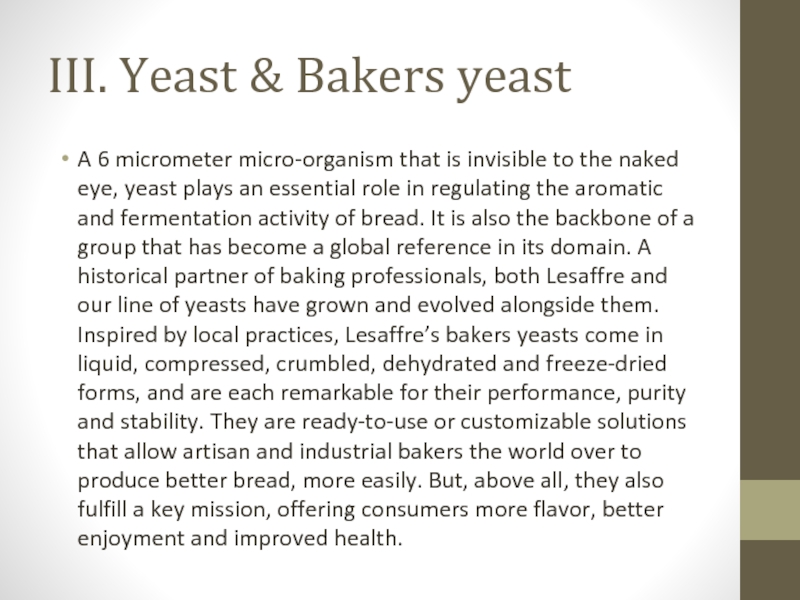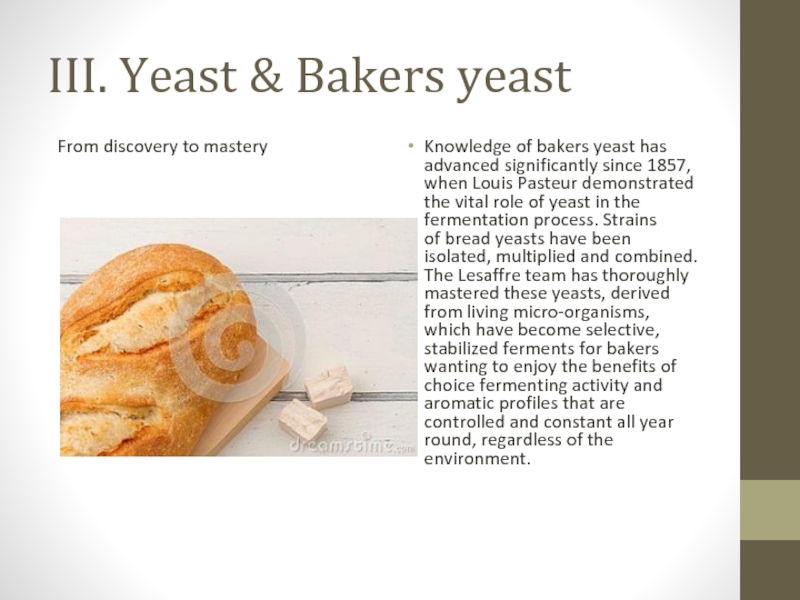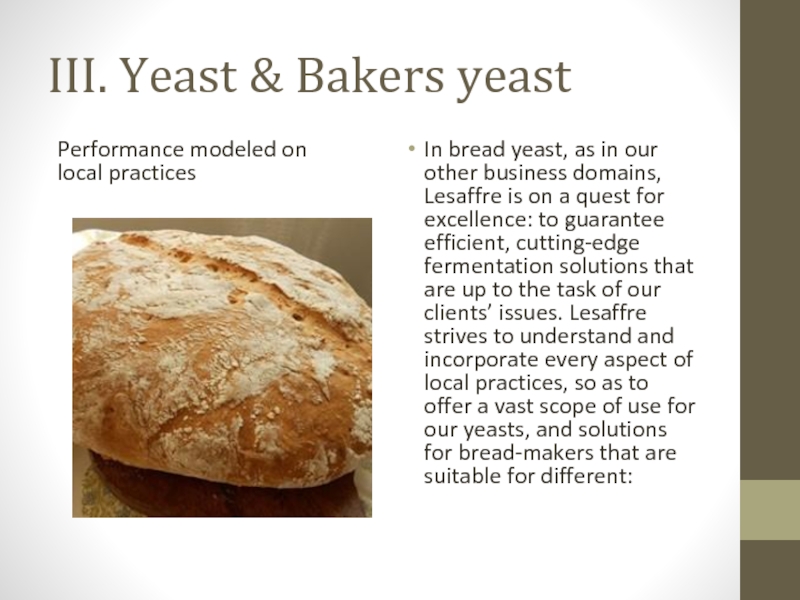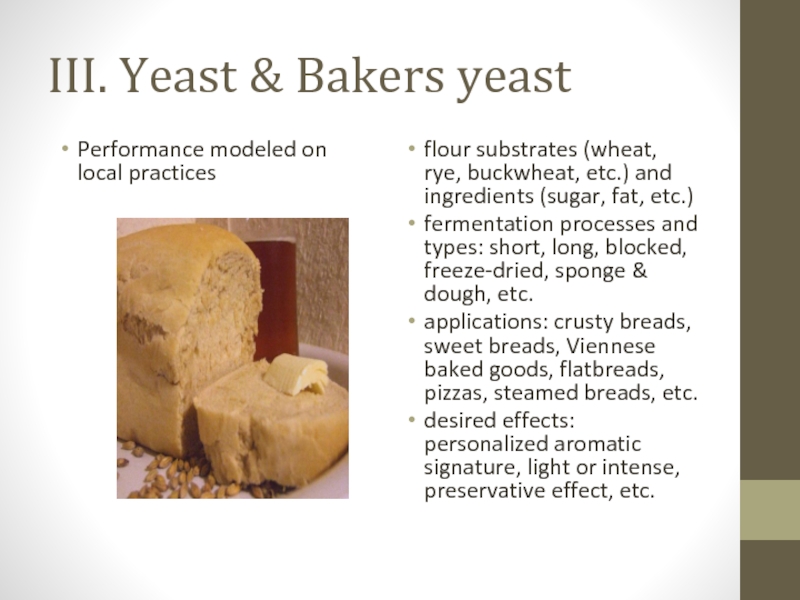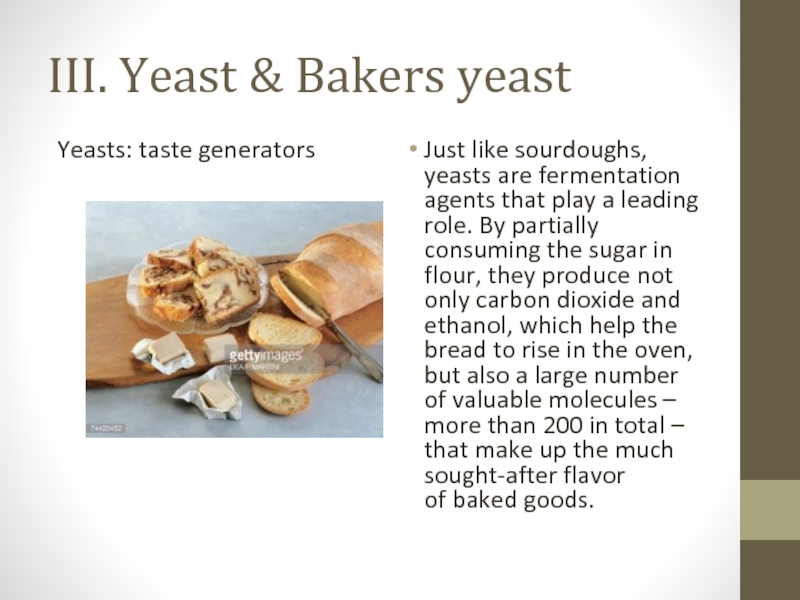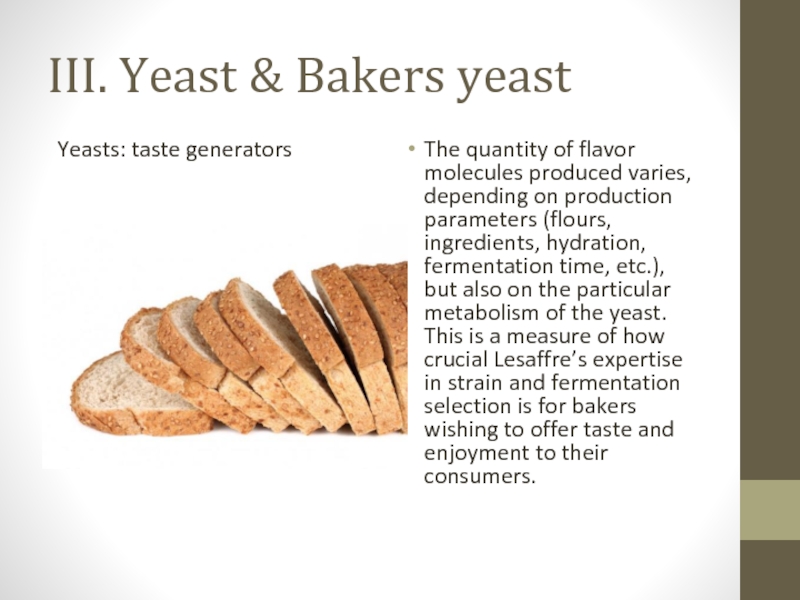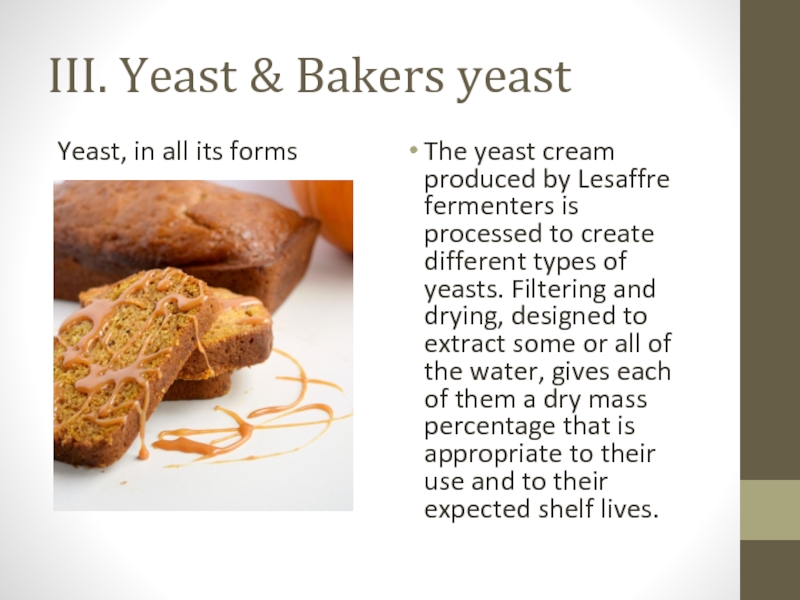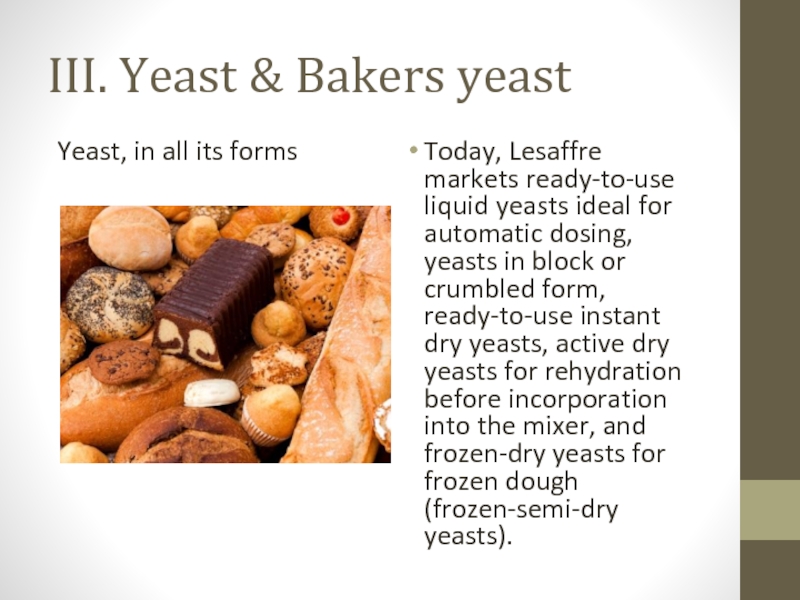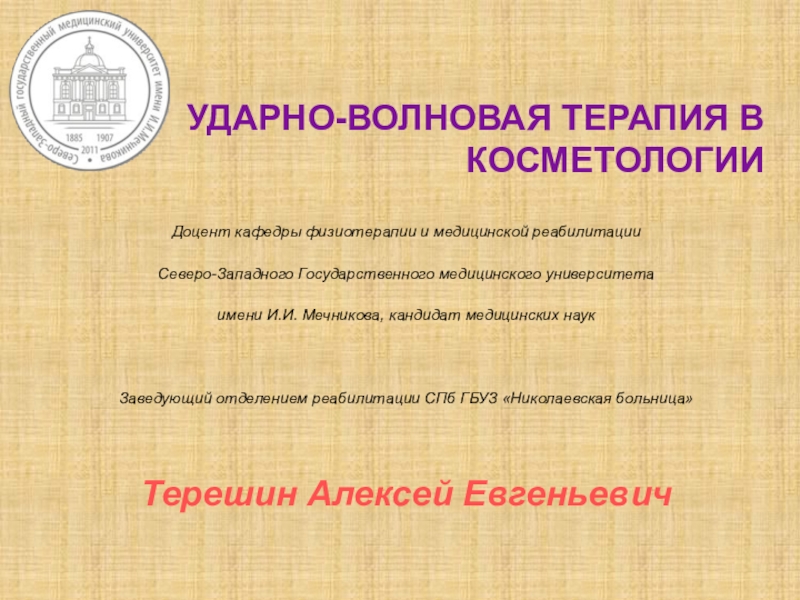Разделы презентаций
- Разное
- Английский язык
- Астрономия
- Алгебра
- Биология
- География
- Геометрия
- Детские презентации
- Информатика
- История
- Литература
- Математика
- Медицина
- Менеджмент
- Музыка
- МХК
- Немецкий язык
- ОБЖ
- Обществознание
- Окружающий мир
- Педагогика
- Русский язык
- Технология
- Физика
- Философия
- Химия
- Шаблоны, картинки для презентаций
- Экология
- Экономика
- Юриспруденция
Bread and baker's yeast
Содержание
- 1. Bread and baker's yeast
- 2. PLANBaker's yeastTypes of baker's yeastYeast & Bakers yeast
- 3. I. Baker's yeastBaker's yeast is the common name
- 4. I. Baker's yeastThe use of steamed or
- 5. I. Baker's yeastSaccharomyces exiguus (also known as S. minor)
- 6. II. Types of baker's yeastBaker's yeast is
- 7. II. Types of baker's yeastCream yeastCream yeast is
- 8. II. Types of baker's yeastCompressed yeastCompressed yeast is,
- 9. II. Types of baker's yeastActive dry yeastActive
- 10. II. Types of baker's yeastInstant yeastInstant yeast appears
- 11. II. Types of baker's yeastRapid-rise yeastRapid-rise yeast is
- 12. II. Types of baker's yeastDeactivated yeastDeactivated yeast is
- 13. II. Types of baker's yeastFor most commercial
- 14. III. Yeast & Bakers yeastA 6 micrometer
- 15. III. Yeast & Bakers yeastFrom discovery to
- 16. III. Yeast & Bakers yeastPerformance modeled on
- 17. III. Yeast & Bakers yeastPerformance modeled on
- 18. III. Yeast & Bakers yeastYeasts: taste generatorsJust
- 19. III. Yeast & Bakers yeastYeasts: taste generatorsThe
- 20. III. Yeast & Bakers yeastYeast, in all
- 21. III. Yeast & Bakers yeastYeast, in all
- 22. Скачать презентанцию
PLANBaker's yeastTypes of baker's yeastYeast & Bakers yeast
Слайды и текст этой презентации
Слайд 4I. Baker's yeast
The use of steamed or boiled potatoes, water from potato
boiling, or sugar in a bread dough provides food for the
growth of yeasts; however, too much sugar will dehydrate them. Yeast growth is inhibited by both salt and sugar, but more so with salt than sugar. Fats, such as butter or eggs, slow down yeast growth; however, others say the effect of fat on dough remains unclear, presenting evidence that small amounts of fat are beneficial for baked bread volume.Слайд 5I. Baker's yeast
Saccharomyces exiguus (also known as S. minor) is a wild
yeast found on plants, fruits, and grains that is occasionally
used for baking; however, in general it is not used in a pure form but comes from being propagated in a sourdough starter.Слайд 6II. Types of baker's yeast
Baker's yeast is available in a
number of different forms, the main differences being the moisture
contents. Though each version has certain advantages over the others, the choice of which form to use is largely a question of the requirements of the recipe at hand and the training of the cook preparing it. Dry yeast forms are good choices for longer-term storage, often lasting more than a year at room temperatures without significant loss of viability. In general, with occasional allowances for liquid content and temperature, the different forms of commercial yeast are considered interchangeableСлайд 7II. Types of baker's yeast
Cream yeast
Cream yeast is the closest form
to the yeast slurries of the 19th century, in essence
being a suspension of yeast cells in liquid, siphoned off from the growth medium. Its primary use is in industrial bakeries with special high-volume dispensing and mixing equipment, and it is not readily available to small bakeries or home cooks.Слайд 8II. Types of baker's yeast
Compressed yeast
Compressed yeast is, in essence, cream
yeast with most of the liquid removed. It is a
soft solid, beige in color, and best known in the consumer form as small, foil-wrapped cubes of cake yeast. It is also available in larger-block form for bulk usage. It is highly perishable; though formerly widely available for the consumer market, it has become less common in supermarkets in some countries due to its poor keeping properties, having been superseded in some such markets by active dry and instant yeast. It is still widely available for commercial use, and is somewhat more tolerant of low temperatures than other forms of commercial yeast; however, even there, instant yeast has made significant market inroads.Слайд 9II. Types of baker's yeast
Active dry yeast
Active dry yeast is the
form of yeast most commonly available to noncommercial bakers in
the United States. It consists of coarse oblong granules of yeast, with live yeast cells encapsulated in a thick jacket of dry, dead cells with some growth medium. Under most conditions, active dry yeast must first be proofed or rehydrated. It can be stored at room temperature for a year, or frozen for more than a decade, which means that it has better keeping qualities than other forms, but it is generally considered more sensitive than other forms to thermal shock when actually used in recipes.Слайд 10II. Types of baker's yeast
Instant yeast
Instant yeast appears similar to active
dry yeast, but has smaller granules with substantially higher percentages
of live cells per comparable unit volumes. It is more perishable than active dry yeast but also does not require rehydration, and can usually be added directly to all but the driest doughs. In general, instant yeast has a small amount of ascorbic acid added as a preservative. Some producers provide two or more forms of instant yeast in their product portfolio; for example, LeSaffre's "SAF Instant Gold" is designed specifically for doughs with high sugar contents, and such yeasts are more generally known as osmotolerant yeasts.Слайд 11II. Types of baker's yeast
Rapid-rise yeast
Rapid-rise yeast is a variety of
dried yeast (usually a form of instant yeast) that is
of a smaller granular size, thus it dissolves faster in dough, and it provides greater carbon dioxide output to allow faster rising. There is considerable debate as to the value of such a product; while most baking experts believe it reduces the flavor potential of the finished product, Cook's Illustrated magazine, among others, feels that, at least for direct-rise recipes, it makes little difference. Rapid-rise yeast is often marketed specifically for use in bread machines.Слайд 12II. Types of baker's yeast
Deactivated yeast
Deactivated yeast is dead yeast which
has no leavening value and is not interchangeable with other
yeast types. Typically used for pizza and pan bread doughs, it is used at a rate of 0.1% of the flour weight, though manufacturer specifications may vary. It is a powerful reducing agent used to increase the extensibility of a dough.Слайд 13II. Types of baker's yeast
For most commercial uses, yeast of
any form is packaged in bulk (blocks or freezer bags
for fresh yeast; vacuum-packed brick bags for dry or instant); however, yeast for home use is often packaged in pre-measured doses, either small squares for compressed yeast or sealed packets for dry or instant. For active dry and instant yeast, in general a single dose (reckoned for the average bread recipe of between 500 g and 1000 g of dough) is about 2.5 tsp (~12 mL) or about 7 g (1⁄4 oz), though comparatively lesser amounts are used when the yeast is used in a pre-ferment. In general, a yeast flavor in the baked bread is not noticeable when the bakers' percent of added yeast is less than 2.5%.Слайд 14III. Yeast & Bakers yeast
A 6 micrometer micro-organism that is
invisible to the naked eye, yeast plays an essential role
in regulating the aromatic and fermentation activity of bread. It is also the backbone of a group that has become a global reference in its domain. A historical partner of baking professionals, both Lesaffre and our line of yeasts have grown and evolved alongside them. Inspired by local practices, Lesaffre’s bakers yeasts come in liquid, compressed, crumbled, dehydrated and freeze-dried forms, and are each remarkable for their performance, purity and stability. They are ready-to-use or customizable solutions that allow artisan and industrial bakers the world over to produce better bread, more easily. But, above all, they also fulfill a key mission, offering consumers more flavor, better enjoyment and improved health.Слайд 15III. Yeast & Bakers yeast
From discovery to mastery
Knowledge of bakers yeast
has advanced significantly since 1857, when Louis Pasteur demonstrated the
vital role of yeast in the fermentation process. Strains of bread yeasts have been isolated, multiplied and combined. The Lesaffre team has thoroughly mastered these yeasts, derived from living micro-organisms, which have become selective, stabilized ferments for bakers wanting to enjoy the benefits of choice fermenting activity and aromatic profiles that are controlled and constant all year round, regardless of the environment.Слайд 16III. Yeast & Bakers yeast
Performance modeled on local practices
In bread yeast,
as in our other business domains, Lesaffre is on a
quest for excellence: to guarantee efficient, cutting-edge fermentation solutions that are up to the task of our clients’ issues. Lesaffre strives to understand and incorporate every aspect of local practices, so as to offer a vast scope of use for our yeasts, and solutions for bread-makers that are suitable for different:Слайд 17III. Yeast & Bakers yeast
Performance modeled on local practices
flour substrates
(wheat, rye, buckwheat, etc.) and ingredients (sugar, fat, etc.)
fermentation processes
and types: short, long, blocked, freeze-dried, sponge & dough, etc.applications: crusty breads, sweet breads, Viennese baked goods, flatbreads, pizzas, steamed breads, etc.
desired effects: personalized aromatic signature, light or intense, preservative effect, etc.
